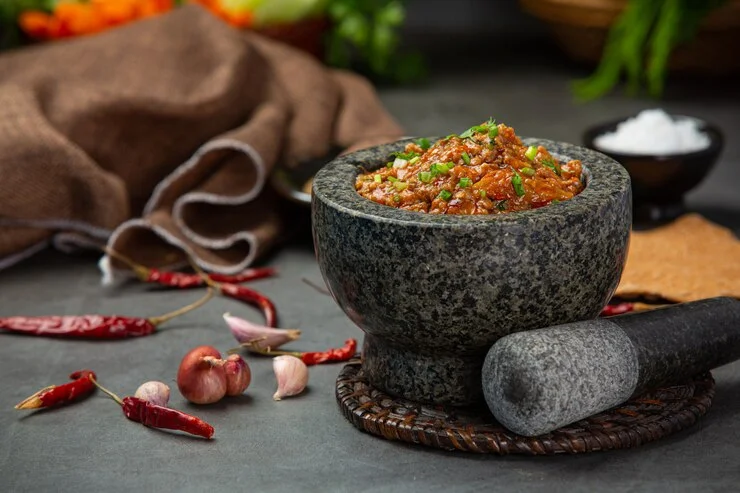Aleppo pepper is gaining popularity in kitchens around the world for its unique, balanced heat and fruity flavor. While it’s commonly used in Middle Eastern and Mediterranean dishes, many cooks are now incorporating Aleppo pepper in curry to add a distinct depth of flavor. But how does Aleppo pepper perform in curries, and how can you best use it? Here, we’ll dive into everything you need to know about adding Aleppo pepper to your curry recipes.
What Is Aleppo Pepper?
Aleppo pepper, also known as Halaby pepper, originates from the town of Aleppo in Syria. It’s a dried, crushed chili with mild heat and a fruity, slightly smoky flavor. Aleppo pepper is often compared to red chili flakes but with less heat and more complexity.
This spice has a Scoville heat rating of around 10,000 units, making it milder than many other chili peppers. Its appeal comes from its balanced, tangy heat with subtle notes of cumin and sun-dried tomatoes. This makes it perfect for adding warmth to dishes without overwhelming the other flavors.
Can You Use Aleppo Pepper in Curry?
Yes, you can absolutely use Aleppo pepper in curry! It’s an excellent addition to both mild and spicy curries, depending on the flavor profile you’re aiming for. Its milder heat allows you to build layers of spice without making the dish too hot, and its fruity undertones complement the robust flavors of many curries.
Why Aleppo Pepper Works Well in Curry?
Mild Heat
Aleppo pepper offers a mild heat compared to stronger chili varieties like cayenne or Thai chili. This makes it a great choice for people who prefer their curry with just a hint of spiciness. You can also use it in combination with hotter chilies to create a more complex heat profile.
Rich Flavor Profile
Aleppo pepper’s slightly fruity and smoky flavor complements the traditional spices in curry, such as cumin, coriander, and turmeric. It enhances the dish’s overall taste without overshadowing other ingredients, making the curry more balanced and flavorful.
Vibrant Color
Not only does Aleppo pepper enhance the flavor, but it also adds a vibrant red hue to the dish, making your curry look visually appealing. Its color deepens as it cooks, giving the curry a beautiful, rich tone.
How to Use Aleppo Pepper in Curry?
Using Aleppo pepper in curry is simple. Here are a few key tips to make the most of this flavorful spice:
Add Early in the Cooking Process
To fully unlock Aleppo pepper’s flavor, it’s best to add it early during the cooking process. This allows the pepper to infuse its unique heat and flavor into the sauce. Sautéing it with onions, garlic, and other spices helps release its oils and intensifies its fruity notes.
Control the Heat Level
Because Aleppo pepper is milder than most chilies, you can add more of it without making your curry too spicy. This allows for more control over the heat level, so you can adjust it to your liking. Start with 1-2 teaspoons for a mild curry and increase as needed if you prefer more heat.
Use It as a Garnish
Another great way to incorporate Aleppo pepper into curry is by sprinkling it on top as a finishing touch. This adds a splash of color and a touch of flavor, elevating the dish’s presentation while providing a subtle layer of mild heat.

Aleppo Pepper Substitutes for Curry
If you don’t have Aleppo pepper on hand, there are a few substitutes you can use that provide similar heat and flavor profiles:
- Paprika and Cayenne Mix: Combine paprika with a dash of cayenne pepper to mimic the mild heat and fruity undertones of Aleppo pepper.
- Ancho Chili Powder: Another mild chili with fruity notes, ancho chili powder can work well in place of Aleppo pepper, especially in curries.
- Crushed Red Pepper Flakes: These can be used in a pinch, but they have more heat and less depth of flavor than Aleppo pepper, so use them sparingly.
Aleppo Pepper vs. Other Curry Spices
Aleppo Pepper vs. Cayenne
While cayenne is much hotter than Aleppo pepper, both can be used in curries. Aleppo pepper is better for a more subtle, layered heat, while cayenne is ideal if you’re aiming for a spicier kick.
Aleppo Pepper vs. Paprika
Paprika and Aleppo pepper share similar smoky, fruity notes, but paprika tends to be sweeter. Aleppo pepper has a touch more heat and complexity, making it a more versatile spice for curries.
Aleppo Pepper vs. Red Chili Flakes
Red chili flakes are coarser and spicier than Aleppo pepper. While both can work in curries, Aleppo pepper is better for more delicate, balanced heat, while chili flakes are suited for dishes where you want a strong, spicy bite.
Popular Curry Recipes with Aleppo Pepper
Here are a few popular curry dishes where Aleppo pepper can shine:
Chicken Curry
Aleppo pepper works beautifully in chicken curry. Its mild heat complements the savory flavors of chicken, coconut milk, and traditional Indian spices. You can either add it to the curry base or use it as a garnish on top.
Vegetable Curry
For a lighter dish, Aleppo pepper pairs well with vegetable-based curries. It adds warmth without overpowering the delicate flavors of fresh vegetables like carrots, potatoes, and spinach.
Lentil Curry (Dal)
Lentil curries are perfect for experimenting with spices, and Aleppo pepper adds a nuanced heat that elevates the earthiness of lentils. Its fruity notes work well with the richness of ghee or coconut oil typically used in dal recipes.
Spicy Fish Curry
Aleppo pepper’s subtle fruitiness is a great match for fish curries. Whether you’re making a South Indian-style fish curry or a Thai coconut fish dish, Aleppo pepper will enhance the flavor without overpowering the fish.
Health Benefits of Aleppo Pepper
In addition to its culinary uses, Aleppo pepper also comes with several health benefits:
- Rich in Antioxidants: Like other chili peppers, Aleppo pepper contains capsaicin, which is known for its antioxidant and anti-inflammatory properties.
- Boosts Digestion: Aleppo pepper can help stimulate digestion, aiding in the breakdown of food and improving overall digestive health.
- Improves Circulation: Capsaicin also has circulation-boosting effects, which can help improve blood flow and support cardiovascular health.
How to Store Aleppo Pepper?
To maintain the freshness and potency of Aleppo pepper, proper storage is key:
- Store in an airtight container: Keep Aleppo pepper in an airtight container to prevent moisture from entering, which can cause the spice to lose its flavor.
- Keep it in a cool, dry place: Store your Aleppo pepper in a cool, dry spot away from direct sunlight. A pantry or spice cabinet works perfectly.
FAQs
1. Can I use Aleppo pepper in all types of curry?
Yes, Aleppo pepper works well in a variety of curries, from mild to spicy, including Indian, Thai, and even fusion curries.
2. Is Aleppo pepper too mild for a hot curry?
Aleppo pepper is milder than some other chili options, but you can combine it with hotter chilies like cayenne or serrano to achieve the desired heat level.
3. Where can I buy Aleppo pepper?
Aleppo pepper is available at specialty spice stores, some larger supermarkets, and online retailers. Be sure to buy from a trusted source to ensure authenticity and quality.
4. How much Aleppo pepper should I use in curry?
Start with 1-2 teaspoons of Aleppo pepper for a mild curry and adjust the quantity based on your heat preference.
Conclusion
Using Aleppo pepper in curry is an excellent way to introduce a new layer of flavor and subtle heat to your dishes. Its fruity, smoky taste enhances the traditional spices used in curry, offering a balanced and complex flavor profile. Whether you’re cooking a mild chicken curry or a rich lentil dish, Aleppo pepper adds depth without overpowering the other ingredients. Plus, its mild heat makes it versatile enough for all types of curries, from Indian to Thai. So next time you’re preparing a curry, consider reaching for Aleppo pepper to spice things up!









